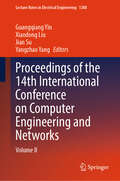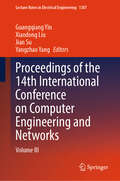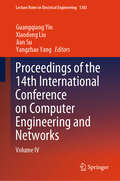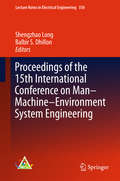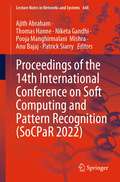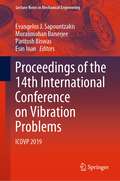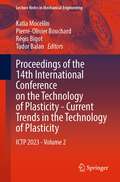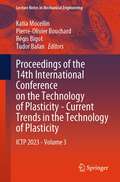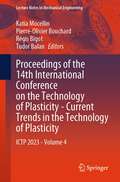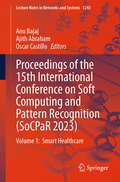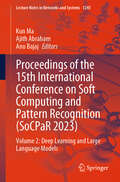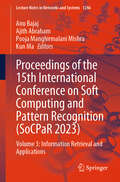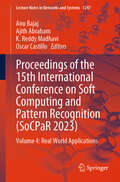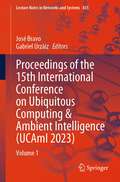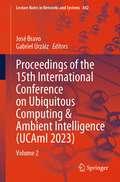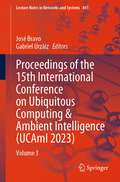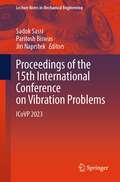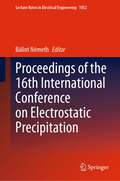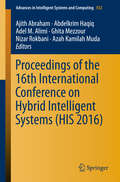- Table View
- List View
Proceedings of the 14th International Conference on Computer Engineering and Networks: Volume II (Lecture Notes in Electrical Engineering #1388)
by Xiaodong Liu Jian Su Guangqiang Yin Yangzhao YangThis conference proceedings is a collection of papers accepted for CENet2024 - the 14th International Conference on Computer Engineering and Networks, held in Kashi, China, 18-21 October 2024. The topics covered include Internet of Things and Smart Systems, Artificial Intelligence and Applications, Detection, Analysis and Application of Communication Systems, Cloud Computing and Security, and Medical Engineering and Information Systems. Each section of this book can serve as an excellent reference for industry practitioners, university faculty, research fellows, undergraduate and graduate students who wish to build a knowledge base of the latest advances and state-of-the-art practices in the topics covered. Using this knowledge, they will be able to design, implement and manage systems that are both complex and trustworthy. We would like to thank the authors for their hard work and dedication, and the reviewers for their efforts in ensuring that only the highest quality papers were selected. Without their contributions, the proceedings would not have been possible.
Proceedings of the 14th International Conference on Computer Engineering and Networks: Volume III (Lecture Notes in Electrical Engineering #1387)
by Xiaodong Liu Jian Su Guangqiang Yin Yangzhao YangThis conference proceedings is a collection of papers accepted for CENet2024 - the 14th International Conference on Computer Engineering and Networks, held in Kashi, China, 18-21 October 2024. The topics covered include Internet of Things and Smart Systems, Artificial Intelligence and Applications, Detection, Analysis and Application of Communication Systems, Cloud Computing and Security, and Medical Engineering and Information Systems. Each section of this book can serve as an excellent reference for industry practitioners, university faculty, research fellows, undergraduate and graduate students who wish to build a knowledge base of the latest advances and state-of-the-art practices in the topics covered. Using this knowledge, they will be able to design, implement and manage systems that are both complex and trustworthy. We would like to thank the authors for their hard work and dedication, and the reviewers for their efforts in ensuring that only the highest quality papers were selected. Without their contributions, the proceedings would not have been possible.
Proceedings of the 14th International Conference on Computer Engineering and Networks: Volume IV (Lecture Notes in Electrical Engineering #1383)
by Xiaodong Liu Jian Su Guangqiang Yin Yangzhao YangThis conference proceedings is a collection of papers accepted for CENet2024 - the 14th International Conference on Computer Engineering and Networks, held in Kashi, China, 18-21 October 2024. The topics covered include Internet of Things and Smart Systems, Artificial Intelligence and Applications, Detection, Analysis and Application of Communication Systems, Cloud Computing and Security, and Medical Engineering and Information Systems. Each section of this book can serve as an excellent reference for industry practitioners, university faculty, research fellows, undergraduate and graduate students who wish to build a knowledge base of the latest advances and state-of-the-art practices in the topics covered. Using this knowledge, they will be able to design, implement and manage systems that are both complex and trustworthy. We would like to thank the authors for their hard work and dedication, and the reviewers for their efforts in ensuring that only the highest quality papers were selected. Without their contributions, the proceedings would not have been possible.
Proceedings of the 14th International Conference on Man-Machine-Environment System Engineering
by Balbir S. Dhillon Shengzhao LongThe integrated and advanced science research topic man-machine-environment system engineering (MMESE) was first established in China by Professor Shengzhao Long in 1981, with direct support from one of the greatest modern Chinese scientists, Xuesen Qian. In a letter to Shengzhao Long from October 22nd, 1993, Xuesen Qian wrote: "You have created a very important modern science and technology in China!" MMESE primarily focuses on the relationship between man, machines and the environment, studying the optimum combination of man-machine-environment systems. In this system, "man" refers to people in the workplace (e. g. operators, decision-makers); " machine" is the general name for any object controlled by man (including tools, machinery, computers, systems and technologies), and "environment" describes the specific working conditions under which man and machine interact (e. g. temperature, noise, vibration, hazardous gases etc. ). The three goals of optimization of man-machine-environment systems are to ensure safety, efficiency and economy. Proceedings of the 14th International Conference on Man-Machine-Environment System Engineering are an academic showcase of the best papers selected from more than 400 submissions, introducing readers to the top research topics and the latest developmental trends in the theory and application of MMESE. These proceedings are interdisciplinary studies on the concepts and methods of physiology, psychology, system engineering, computer science, environment science, management, education, and other related disciplines. Researchers and professionals working in these interdisciplinary fields and researchers on MMESE related topics will benefit from these proceedings.
Proceedings of the 14th International Conference on Man-Machine-Environment System Engineering (Lecture Notes in Electrical Engineering #318)
by Balbir S. Dhillon Shengzhao LongThe integrated and advanced science research topic man-machine-environment system engineering (MMESE) was first established in China by Professor Shengzhao Long in 1981, with direct support from one of the greatest modern Chinese scientists, Xuesen Qian. In a letter to Shengzhao Long from October 22nd, 1993, Xuesen Qian wrote: “You have created a very important modern science and technology in China!” MMESE primarily focuses on the relationship between man, machines and the environment, studying the optimum combination of man-machine-environment systems. In this system, “man” refers to people in the workplace (e.g. operators, decision-makers); “ machine” is the general name for any object controlled by man (including tools, machinery, computers, systems and technologies), and “environment” describes the specific working conditions under which man and machine interact (e.g. temperature, noise, vibration, hazardous gases etc.). The three goals of optimization of man-machine-environment systems are to ensure safety, efficiency and economy. Proceedings of the 14th International Conference on Man-Machine-Environment System Engineering are an academic showcase of the best papers selected from more than 400 submissions, introducing readers to the top research topics and the latest developmental trends in the theory and application of MMESE.These proceedings are interdisciplinary studies on the concepts and methods of physiology, psychology, system engineering, computer science, environment science, management, education, and other related disciplines. Researchers and professionals working in these interdisciplinary fields and researchers on MMESE related topics will benefit from these proceedings.
Proceedings of the 14th International Conference on Soft Computing and Pattern Recognition (Lecture Notes in Networks and Systems #648)
by Ajith Abraham Patrick Siarry Thomas Hanne Niketa Gandhi Pooja Manghirmalani Mishra Anu BajajThis book highlights the recent research on soft computing, pattern recognition, nature-inspired computing, and their various practical applications. It presents 69 selected papers from the 14th International Conference on Soft Computing and Pattern Recognition (SoCPaR 2022) and 19 papers from the 14th World Congress on Nature and Biologically Inspired Computing (NaBIC 2022), which was held online, from December 14 to 16, 2022. A premier conference in the field of soft computing, artificial intelligence, and machine learning applications, SoCPaR-NaBIC 2022 brought together researchers, engineers, and practitioners whose work involves intelligent systems, network security, and their applications in industry. Including contributions by authors from over 25 countries, the book offers a valuable reference guide for all researchers, students, and practitioners in the fields of computer science and engineering.
Proceedings of the 14th International Conference on Sustainable Built Environment: ICSBE 2023, 15th–17th December, Kandy, Sri Lanka (Lecture Notes in Civil Engineering #517)
by Ranjith Dissanayake Priyan Mendis Sudhira De Silva Shiromal Fernando Chaminda Konthesingha Pradeep Gajanayake Upul AttanayakeThis book highlights the latest knowledge and innovations in the fields of civil engineering and construction industry striving for a sustainable built environment. This book consists of high-quality innovative research findings selected from the proceedings of the 14th International Conference on Sustainable Built Environment (ICSBE 2023) under the themes of Sustainable construction, urban green infrastructure and planning, rainwater harvesting and water conservation, high-performance concrete, indoor environmental quality and indoor plants, wind and hydro-power energy, waste and wastewater management for enhanced sustainability, impacts of climate change, carbon footprint, global climate model and landscaping, material flows and industrial ecology, sustainable materials, etc.
Proceedings of the 14th International Conference on Vibration Problems: ICOVP 2019 (Lecture Notes in Mechanical Engineering)
by Paritosh Biswas Esin Inan Evangelos J. Sapountzakis Muralimohan BanerjeeThis book presents the select proceedings of the 14th International Conference on Vibration Problems (ICOVP 2019) held in Crete, Greece. The volume brings together contributions from researchers working on vibration related problems in a wide variety of engineering disciplines such as mechanical engineering, wind and earthquake engineering, nuclear engineering, aeronautics, robotics, and transport systems. The focus is on latest developments and cutting-edge methods in wave mechanics and vibrations, and includes theoretical, experimental, as well as applied studies. The range of topics and the up-to-date results covered in this volume make this interesting for students, researchers, and professionals alike.
Proceedings of the 14th International Conference on the Technology of Plasticity - Current Trends in the Technology of Plasticity: ICTP 2023 - Volume 1 (Lecture Notes in Mechanical Engineering)
by Katia Mocellin Pierre-Olivier Bouchard Régis Bigot Tudor BalanThis volume highlights the latest advances, innovations, and applications in the field of metal forming, as presented by leading international researchers and engineers at the 14th International Conference on Technology of Plasticity (ICTP), held in Mandelieu-La Napoule, France on September 24-29, 2023. It covers a diverse range of topics such as manufacturing processes & equipment, materials behavior and characterization, microstructure design by forming, surfaces & interfaces, control & optimization, green / sustainable metal forming technologies, digitalization & AI in metal forming, multi-material processing, agile / flexible metal forming processes, forming of non-metallic materials, micro-forming and luxury applications. The contributions, which were selected by means of a rigorous international peer-review process, present a wealth of exciting ideas that will open novel research directions and foster multidisciplinary collaboration among different specialists.
Proceedings of the 14th International Conference on the Technology of Plasticity - Current Trends in the Technology of Plasticity: ICTP 2023 - Volume 2 (Lecture Notes in Mechanical Engineering)
by Katia Mocellin Pierre-Olivier Bouchard Régis Bigot Tudor BalanThis volume highlights the latest advances, innovations, and applications in the field of metal forming, as presented by leading international researchers and engineers at the 14th International Conference on Technology of Plasticity (ICTP), held in Mandelieu-La Napoule, France on September 24-29, 2023. It covers a diverse range of topics such as manufacturing processes & equipment, materials behavior and characterization, microstructure design by forming, surfaces & interfaces, control & optimization, green / sustainable metal forming technologies, digitalization & AI in metal forming, multi-material processing, agile / flexible metal forming processes, forming of non-metallic materials, micro-forming and luxury applications. The contributions, which were selected by means of a rigorous international peer-review process, present a wealth of exciting ideas that will open novel research directions and foster multidisciplinary collaboration among different specialists.
Proceedings of the 14th International Conference on the Technology of Plasticity - Current Trends in the Technology of Plasticity: ICTP 2023 - Volume 3 (Lecture Notes in Mechanical Engineering)
by Katia Mocellin Pierre-Olivier Bouchard Régis Bigot Tudor BalanThis volume highlights the latest advances, innovations, and applications in the field of metal forming, as presented by leading international researchers and engineers at the 14th International Conference on Technology of Plasticity (ICTP), held in Mandelieu-La Napoule, France on September 24-29, 2023. It covers a diverse range of topics such as manufacturing processes & equipment, materials behavior and characterization, microstructure design by forming, surfaces & interfaces, control & optimization, green / sustainable metal forming technologies, digitalization & AI in metal forming, multi-material processing, agile / flexible metal forming processes, forming of non-metallic materials, micro-forming and luxury applications. The contributions, which were selected by means of a rigorous international peer-review process, present a wealth of exciting ideas that will open novel research directions and foster multidisciplinary collaboration among different specialists.
Proceedings of the 14th International Conference on the Technology of Plasticity - Current Trends in the Technology of Plasticity: ICTP 2023 - Volume 4 (Lecture Notes in Mechanical Engineering)
by Katia Mocellin Pierre-Olivier Bouchard Régis Bigot Tudor BalanThis volume highlights the latest advances, innovations, and applications in the field of metal forming, as presented by leading international researchers and engineers at the 14th International Conference on Technology of Plasticity (ICTP), held in Mandelieu-La Napoule, France on September 24-29, 2023. It covers a diverse range of topics such as manufacturing processes & equipment, materials behavior and characterization, microstructure design by forming, surfaces & interfaces, control & optimization, green / sustainable metal forming technologies, digitalization & AI in metal forming, multi-material processing, agile / flexible metal forming processes, forming of non-metallic materials, micro-forming and luxury applications. The contributions, which were selected by means of a rigorous international peer-review process, present a wealth of exciting ideas that will open novel research directions and foster multidisciplinary collaboration among different specialists.
Proceedings of the 14th International Symposium on Computer Science in Sport (Lecture Notes on Data Engineering and Communications Technologies #209)
by Hui Zhang Martin Lames Arnold Baca Yingcai WuThis book is a compilation of selected papers from the 14th International Symposium on Computer Science in Sport (IACSS 2023), held on September 27-30, 2023 in Hangzhou, China. The work focuses on the application of computer science and technology in the field of sports (such as intelligent data collection, data mining, visual analysis of game data, virtual reality, machine learning, computer vision, match prediction models and performance analysis). The contents make valuable contributions to academic researchers, college students, coaches and athletes, and sports management personnel (such as managers of sports associations, training bases, and professional clubs). Additionally, readers will encounter new ideas for realizing a more efficient and convenient training and exercise system.
Proceedings of the 15th International Conference on Axiomatic Design 2023 (Lecture Notes in Networks and Systems #849)
by Joseph Timothy Foley Erik Puik David S. Cochran Petra Foith-FörsterThis book of carefully selected research papers captures the essence of systems engineering. It offers readers a comprehensive exploration in the most recent applications and advancements of Axiomatic Design, a powerful method that elevates the level of product design and manufacturing. Although Axiomatic Design originated at the Massachusetts Institute of Technology (MIT) in Boston, it has been further developed by an active community of users and academics from all over the world. For the 15th time, the International Conference on Axiomatic Design convened global experts to discuss the core of the methodology. Their shared objective was to advance systems engineering, catering to the increasing complexity of modern product design. From over 85 submissions, the program committee selected 20 papers to ensure quality and relevance. Our profound gratitude extends to the contributing authors, whose research and dedication have shaped this collection, and to the program committee members for their unwavering commitment to academic integrity. Through their combined efforts, this document stands as a testament to the innovative spirit and academic excellence synonymous with systems engineering as developed by MIT.
Proceedings of the 15th International Conference on Man–Machine–Environment System Engineering (Lecture Notes in Electrical Engineering #356)
by Balbir S. Dhillon Shengzhao LongThis research topic was first established in China by Professor ShengZhao Long in 1981, with direct support from one of the greatest modern Chinese scientists, XueSen Qian. In a letter to ShengZhao Long from October 22nd, 1993, XueSen Qian wrote: “You have created a very important modern science subject and technology in China!” MMESE primarily focuses on the relationship between Man, Machine and Environment, studying the optimum combination of man-machine-environment systems. In this system, “Man” refers to working people as the subject in the workplace (e.g. operators, decision-makers); “Machine” is the general name for any object controlled by Man (including tools, machinery, computers, systems and technologies), and “Environment” describes the specific working conditions under which Man and Machine interact (e.g. temperature, noise, vibration, hazardous gases etc.). The three goals of optimization are to ensure safety, efficiency and economy. These proceedings are an academic showcase of the best papers selected from more than 400 submissions, introducing readers to the top research topics and the latest developmental trends in the theory and application of MMESE. These proceedings are interdisciplinary studies on the concepts and methods of physiology, psychology, system engineering, computer science, environment science, management, education, and other related disciplines. Researchers and professionals who study an interdisciplinary subject crossing above disciplines or researchers on MMESE subject will be mainly benefited from these proceedings.
Proceedings of the 15th International Conference on Soft Computing and Pattern Recognition: Volume 1: Smart Healthcare (Lecture Notes in Networks and Systems #1243)
by Ajith Abraham Oscar Castillo Anu BajajThis book presents 57 selected papers focused on Smart Health Care from the 14th International Conference on Soft Computing and Pattern Recognition (SoCPaR 2023) and 14th World Congress on Nature and Biologically Inspired Computing (NaBIC 2023), which was held in 5 different cities namely Olten, Switzerland; Porto, Portugal; Kaunas, Lithuania; Greater Noida, India; Kochi, India and in online mode. SoCPaR – NaBIC 2023 had contributions by authors from 39 countries. This Volume offers a valuable reference guide for all medical doctors, scientists, academicians, researchers, students and practitioners in the field of artificial intelligence and smart health care.
Proceedings of the 15th International Conference on Soft Computing and Pattern Recognition: Volume 2: Deep Learning and Large Language Models (Lecture Notes in Networks and Systems #1245)
by Ajith Abraham Kun Ma Anu BajajThis book presents 55 selected papers focused on Deep Learning and Large Language Models from the 14th International Conference on Soft Computing and Pattern Recognition (SoCPaR 2023) and 14th World Congress on Nature and Biologically Inspired Computing (NaBIC 2023). SoCPaR – NaBIC 2023 was held in 5 different cities namely Olten, Switzerland; Porto, Portugal; Kaunas, Lithuania; Greater Noida, India; Kochi, India and in online mode. The conference had contributions by authors from 39 countries. This Volume offers a valuable reference guide for all scientists, academicians, researchers, students and practitioners focused on advanced machine learning including deep learning methods, large language models and its real-world applications.
Proceedings of the 15th International Conference on Soft Computing and Pattern Recognition: Volume 3: Information Retrieval and Applications (Lecture Notes in Networks and Systems #1246)
by Ajith Abraham Kun Ma Pooja Manghirmalani Mishra Anu BajajThis book presents 52 selected papers focused on Information Retrieval and Applications from the 14th International Conference on Soft Computing and Pattern Recognition (SoCPaR 2023) and 14th World Congress on Nature and Biologically Inspired Computing (NaBIC 2023). SoCPaR – NaBIC 2023 was held in 5 different cities namely Olten, Switzerland; Porto, Portugal; Kaunas, Lithuania; Greater Noida, India; Kochi, India and in online mode. The conference had contributions by authors from 39 countries. This Volume offers a valuable reference guide for all scientists, academicians, researchers, students and practitioners focused on Information Retrieval and Applications.
Proceedings of the 15th International Conference on Soft Computing and Pattern Recognition: Volume 4: Real World Applications (Lecture Notes in Networks and Systems #1247)
by Ajith Abraham Oscar Castillo Anu Bajaj K. Reddy MadhaviThis book presents 57 selected papers focused on Real World Applications from the 14th International Conference on Soft Computing and Pattern Recognition (SoCPaR 2023) and 14th World Congress on Nature and Biologically Inspired Computing (NaBIC 2023). SoCPaR – NaBIC 2023 was held in 5 different cities namely Olten, Switzerland; Porto, Portugal; Kaunas, Lithuania; Greater Noida, India; Kochi, India and in online mode. The conference had contributions by authors from 39 countries. This Volume comprising of 57 articles offers a valuable reference guide for all scientists, academicians, researchers, students and practitioners focused on real-world applications of soft computing and nature inspired methodologies.
Proceedings of the 15th International Conference on Ubiquitous Computing & Ambient Intelligence: Volume 1 (Lecture Notes in Networks and Systems #835)
by José Bravo Gabriel UrzáizThis book serves as a comprehensive compilation of groundbreaking research endeavors within the realms of ambient intelligence and ubiquitous computing. These initiatives are pivotal in enabling both researchers and practitioners to discern recent breakthroughs and emerging frontiers in these fields. Encompassing a wide array of domains, including Ambient Active and Assisted Living (A3L), the Internet of Things (IoT), Smart Environments, Data Science, and Human-Ambient Interaction, acts as a valuable resource for scholars, professionals, and graduate students alike. The primary aim of this book is to empower individuals within the academic and professional community to harness this wealth of knowledge. It equips them to tackle innovative challenges and engineer smart and ubiquitous solutions that will shape the landscape of the next decade. By amalgamating insights from various facets of ambient intelligence and ubiquitous computing, this book encourages cross-disciplinary collaboration and fosters a holistic understanding of the field. Thus, it not only highlights the recent strides in these areas but also serves as a roadmap for future exploration and innovation, paving the way for a smarter and more interconnected world.
Proceedings of the 15th International Conference on Ubiquitous Computing & Ambient Intelligence: Volume 2 (Lecture Notes in Networks and Systems #842)
by José Bravo Gabriel UrzáizThis book serves as a comprehensive compilation of groundbreaking research endeavors within the realms of ambient intelligence and ubiquitous computing. These initiatives are pivotal in enabling both researchers and practitioners to discern recent breakthroughs and emerging frontiers in these fields. Encompassing a wide array of domains, including Ambient Active and Assisted Living (A3L), the Internet of Things (IoT), Smart Environments, Data Science, and Human-Ambient Interaction, acts as a valuable resource for scholars, professionals, and graduate students alike. The primary aim of this book is to empower individuals within the academic and professional community to harness this wealth of knowledge. It equips them to tackle innovative challenges and engineer smart and ubiquitous solutions that will shape the landscape of the next decade. By amalgamating insights from various facets of ambient intelligence and ubiquitous computing, this book encourages cross-disciplinary collaboration and fosters a holistic understanding of the field. Thus, it not only highlights the recent strides in these areas but also serves as a roadmap for future exploration and innovation, paving the way for a smarter and more interconnected world.
Proceedings of the 15th International Conference on Ubiquitous Computing & Ambient Intelligence: Volume 3 (Lecture Notes in Networks and Systems #841)
by José Bravo Gabriel UrzáizThis book serves as a comprehensive compilation of groundbreaking research endeavors within the realms of ambient intelligence and ubiquitous computing. These initiatives are pivotal in enabling both researchers and practitioners to discern recent breakthroughs and emerging frontiers in these fields. Encompassing a wide array of domains, including Ambient Active and Assisted Living (A3L), the Internet of Things (IoT), Smart Environments, Data Science, and Human-Ambient Interaction, acts as a valuable resource for scholars, professionals, and graduate students alike. The primary aim of this book is to empower individuals within the academic and professional community to harness this wealth of knowledge. It equips them to tackle innovative challenges and engineer smart and ubiquitous solutions that will shape the landscape of the next decade. By amalgamating insights from various facets of ambient intelligence and ubiquitous computing, this book encourages cross-disciplinary collaboration and fosters a holistic understanding of the field. Thus, it not only highlights the recent strides in these areas but also serves as a roadmap for future exploration and innovation, paving the way for a smarter and more interconnected world.
Proceedings of the 15th International Conference on Vibration Problems: ICoVP 2023 (Lecture Notes in Mechanical Engineering)
by Paritosh Biswas Sadok Sassi Jiri NaprstekThis book presents the Proceedings of the 15th International Conference on Vibration Problems (ICoVP 2023) and covers vibration problems of engineering both in theoretical and applied fields. Various topics covered in this volume are Vibration in Oil and Gas, Structural Dynamics, Structural Health Monitoring, Rotor Dynamics, Measurement Diagnostics in Vibration, Computational methods in Vibration and Wave Mechanics, Dynamics of Coupled Systems, Dynamics of Micro and Macro Systems, Multi-body dynamics, Nonlinear dynamicsReliability of dynamic systems, Vibrations due to solid/liquid phase interaction, Vibrations of transport systems, Seismic Isolation, Soil dynamics, Geotechnical earthquake engineering Dynamics of concrete structures, Underwater shock waves (Tsunami), Vibration control, uncertainty quantification and reliability analysis of dynamic structures, Vibration problems associated with nuclear power reactors, Earthquake engineering, impact and wind loading and vibration in composite structures and fracture mechanics. This book will be useful for both professionals and researchers working on vibrations problems in multidisciplinary areas.
Proceedings of the 16th International Conference on Electrostatic Precipitation (Lecture Notes in Electrical Engineering #1052)
by Bálint NémethThis present book includes selected papers presented at the 16th International Conference on Electrostatic Precipitation. It presents research shortcomings and future orientations in ESP among others, advancements in power supply, modelling, novel applications and new techniques, industrial experience and case studies. Outstanding scientists and engineers worldwide in the field reported their on-going researches. The book is a useful reference for scientists and engineers to keep abreast of the latest developments in environmental science and engineering.
Proceedings of the 16th International Conference on Hybrid Intelligent Systems (HIS #2016)
by Ajith Abraham Azah Kamilah Muda Adel M. Alimi Abdelkrim Haqiq Ghita Mezzour Nizar RokbaniThis book presents the latest research in hybrid intelligent systems. It includes 57 carefully selected papers from the 16th International Conference on Hybrid Intelligent Systems (HIS 2016) and the 8th World Congress on Nature and Biologically Inspired Computing (NaBIC 2016), held on November 21-23, 2016 in Marrakech, Morocco. HIS - NaBIC 2016 was jointly organized by the Machine Intelligence Research Labs (MIR Labs), USA; Hassan 1st University, Settat, Morocco and University of Sfax, Tunisia. Hybridization of intelligent systems is a promising research field in modern artificial/computational intelligence and is concerned with the development of the next generation of intelligent systems. The conference's main aim is to inspire further exploration of the intriguing potential of hybrid intelligent systems and bio-inspired computing. As such, the book is a valuable resource for practicing engineers /scientists and researchers working in the field of computational intelligence and artificial intelligence.
